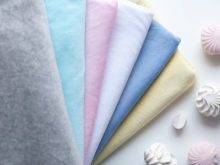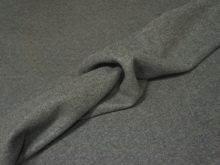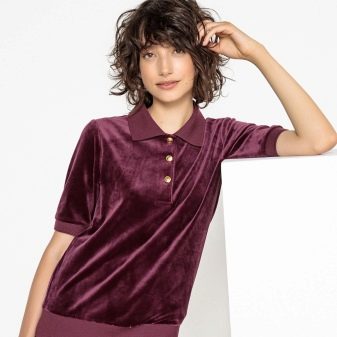Natural velor: features and differences from other materials

Velor is a fabric that has a surface with fibers. It can be made from different raw materials, production technologies are also different. This fabric is used for sewing clothes, upholstery, car interiors and other areas of life. The material has won wide popularity among consumers, this is due to its high quality and attractive appearance.
Types of fabric and its properties
The villi on the velor are rather long and thick. The fabric can be made from natural materials such as cotton, wool, and artificial materials such as lycra and polyester. The composition of the canvas directly affects where exactly it will be used. The visual separation looks like this.
- Smooth velor has a flat surface. The villi run vertically relative to the base.
- The surface of the shaped velor is not uniform. In some parts of the canvas, it can be smoother, with a sort of crumpled pile.
- In some areas of the embossed velor, the villi are stacked differently from the rest. On the way out, it creates beautiful designs and decorative elements.
- Plain-colored velor is most often used in clothing and everyday life. If such fabric is draped, it will shimmer, which will add charm to the overall appearance.
- Printed velor gets its name from the pattern that covers the entire surface. This adds sophistication to the canvas, it looks more expensive.





Separation according to the composition of raw materials and purpose.
- Cotton velor. It is very soft, but, despite this, it is quite dense and wears out heavily.It is made, as the name implies, from cotton threads, therefore it is able to "breathe", which makes it possible to use it even for sewing children's clothes. Sometimes synthetics can be added to cotton, such fabrics are called knitted velor.
- Wool velor... Very warm, due to which it is used for the manufacture of outerwear and hats. Such a material is made on the basis of cloth yarn and has a small, but very thick pile.
- Drap velor. This fabric is also made from wool fibers, and a certain type of wool is used - from merino sheep. Quite durable and very high quality material. The weave is done in a satin style. Such fabrics are considered to be the "luxury" level.



- Furniture velor. These fabrics are combined according to the area of use and are exclusively used for upholstery. The composition in this case is not fundamental. For example, silk or wool velor can be used.

- Jacquard velor. Differs in large patterns over the entire surface and has a small pile. It is often used for upholstering furniture, as it looks very expensive and stylish on it.
- Automotive velor. This material is made specifically for covering car interiors. It is made from synthetic raw materials. Differs in a presentable appearance, practically does not wear out and has good durability.


How is it different from velvet?
Velvet is made using the five-thread technology and is a rather complicated process. Woolen, silk and cotton fibers are taken as a basis. This had an impact on the price, since ancient times velvet has been considered a very expensive material. Caring for velvet is also quite difficult, it requires constant cleaning, otherwise the fabric will lose its presentable appearance. However, the purchase of velvet is not affordable for everyone, so an analogue appeared on the market, which significantly differs in cost. It became velor.
The visual difference from velvet is that the canvas has a higher and thicker pile. The base turns out to be softer, since it contains not only 100% cotton and wool, but also synthetics.


How is it different from corduroy?
Corduroy, like velor, refers to pile materials. The fabric is very pleasant to the touch, it is extremely durable and at the same time looks stylish. Cotton and synthetics take part in the production. The material is distinguished by longitudinal ribs along the entire surface. Corduroy is widely used in various areas of life. It can be used in the manufacture of clothing, to decorate window openings, as upholstery for furniture.
However, one cannot but say about the minus of this material - if it is incorrectly washed, rubbed and wrung out, it will shrink, which means that the thing will be hopelessly ruined. In this case, velor certainly wins, since there are no such strong restrictions in caring for it.

How is it different from suede?
The range of application of velor is wide enough. It is used for sewing clothes. In addition, suede makes great bags and very stylish shoes. Outwardly, velor is very similar to suede. Both materials have a velvety surface, vibrant colors and are also natural. However, despite the similar characteristics, differences can be noticed. The difference is in the quality of the leather, the way it is processed, and the length of the villi. It is these indicators that determine how long the material can be used, and accordingly, the price changes.
For the production of suede, more expensive leather is used, but for velor, possible defects on it are not scary. Velor is able to get wet in a shorter time, in addition, it can undergo deformation when wet. Accordingly, if boots made of this material quickly get wet and then lose their shape, consumer reviews will not be too rosy.
In order not to be mistaken in the choice, you need to carefully examine the proposed product.The pile that comes from above is thicker and longer just at the velor, while from contact with something it is able to change its direction. Moreover, the difference is noticeable in the tailoring. If, in the case of velor, the edge will definitely be bent, then in suede it will simply be cut off.

Dignity
Despite the rich species diversity, all velor materials have a lot of advantages. This material is very durable, therefore, the process of wear and tear does not occur so quickly. It does not stretch or shrink even after prolonged use. Consumers note that the fabric is very pleasant to the touch, is able to keep warm well and at the same time "breathes".
Such material is not capable of provoking an allergic reaction, since it contains mainly natural ingredients, therefore even children's clothing is made from it. The color is uniform and lasts a long time. In addition, due to the ability to reflect light, the fabric plays beautifully in various shades. And, finally, which is important, velor is easy to clean.


Care
As with any material, it is necessary to properly care for velor so that it retains a presentable appearance and quality characteristics for a long time. It should be noted that the procedures are quite simple, however, there are some subtleties. It is necessary to wash velor at a temperature of no more than 30 degrees. If this is done in a washing machine, you need to set the delicate mode. Do not use bleaches. It is also best to use gentle detergents.
It is not required to squeeze the material, the water will drain off perfectly on its own. Also, the fabric is not able to wrinkle, so it does not require ironing. Use a soft sponge or special brush to remove stains.

How to care for suede and velor shoes, see below.








